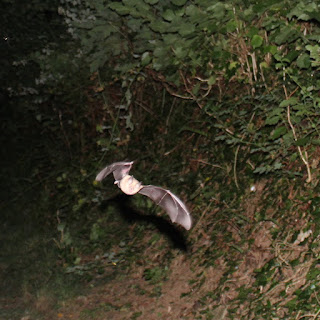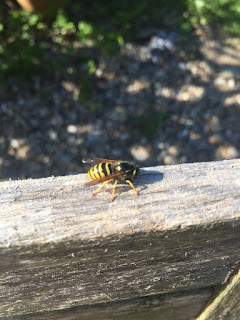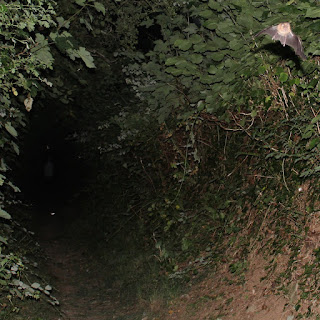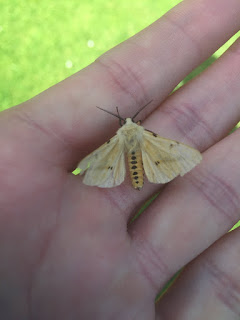I sat on one of my wooden garden chairs a few weeks ago and it gave way beneath me, sending me crashing to the ground. I was somewhat rattled, but unhurt, and less rattled when I realised that the only major witnesses to my indignity were two seagulls and the most empathetic of my four cats. I doubt my weight was much of a factor in the breakage since I am, in the words of a man I once paid to adjust a shirt, “built like a whippet”, therefore I am blaming my local wasps. These wasps have been nibbling industriously on my garden furniture for two and a half years and, while the wasps are very small and their work is gradual, my hunch is that their adherence to a diligent long term plan has finally weakened the structure. The chair is the second part of the patio set to break this year – the other being half of the sofa section, which came in useful as fuel in the unusually cold late spring of this year when I had run out of logs.
If the weather is dry, the wasps and I often sit on my broken garden furniture in the morning and have breakfast together. I normally have muesli. The wasps are quite content with wood, which they take straight, without milk. I look carefully at what I’m eating and drinking before I put it in my mouth, as I don’t want my tongue to get stung and swell up and suffocate me, but I don’t think the wasps want any trouble. They get on cheerfully with their thing, and I get on with mine. They’re in good spirits right now, far different to what they will be in a month or two, when their tempers will flare, due to being, in the memorable words of my gardener friend Andy, “drunk and out of work”.
On paper, I have more reasons to be nervous around wasps than most. And, as any self-regarding wasp will tell you: paper is important. When I was eight, a few days after I’d fallen through a garage window, ripping open the underside of my arm and getting rushed to hospital for several stitches, an Italian wasp planted its sting deep inside the fresh wound. I should point out that I was in Italy at the time of the sting and the wasp had not travelled overseas specifically to hurt me, although I sense that its malevolence was such that it probably would have thought little of doing so. If I close my eyes now I can still feel the spiteful acid furnace of pain I experienced. It was one of many examples I’d seen of just how formidable insects were in Italy: a country where, on the same family holiday, I’d witnessed thirteen ants successfully carrying a whole baguette along a medieval wall. Wasps left me to get on with my life in peace for many years after childhood until one day in Norfolk in 2013 when four of them simultaneously stung me on the bottom in my garden. I had just mowed over their nest, though, so who could blame them? I hadn’t realised the nest was there, but you know what it is like with wasps: they are not interested in going back over the nuances of a fracas.
I have since come around to wasps: they’re formidable architects, they kill lots of garden pests, they pollinate much more than people tend to believe and they helped humans invent paper – a fact that throws into doubt the long held view of them as the antibookish thug counterparts to bees’ gentle selfless intellectuals. At this time of year any defects they might have are also put into sharp perspective by the horseflies across the road from my house. To date, I have never encountered a nice horsefly. Even the one horsefly I met who seemed sort of ok and didn’t bite me probably later turned out to be a scientologist. I must have been bitten by fifty of them when I went alpaca trekking in Norfolk in 2011. “I will never forget what your legs looked like on that day,” my friend Will told me. “That’s such a beautiful thing to say,” I replied, before realising he was referring to the horror film runnels of blood that had streamed down my shins. I don’t know how the Jersey cows who live near me cope. If I had as many horseflies around me as they do right now, I’d be sarcastic and hard to get on with, but they’re always up for a cuddle when I walk the footpath through their field.
Insect Day arrived late this year. This is the twenty four hour period when all the insects in the South West of the UK get together and agree to all crawl and fly into my front room at exactly the same time. I remember the exact day, as it was the one where I saw my cat Roscoe pumelling a small creature against the French window with her paw. I hurried outside and removed Roscoe from the creature, which turned out to be the biggest cockchafer beetle I had ever seen. The cockchafer flew into the air, its wingspan covering such an area it could have been mistaken for a dragonfly. It was a warm night and I was drinking beer with my friend Charlotte, who had never seen a cockchafer before. “Do you get many moths here?” she asked. “I have a bit of a phobia of moths.” Remembering the two hundred or so that make my house their home between June and October, I felt it was best to phrase my answer carefully, but without factual inaccuracies I might be called on to account for later. “Some… but I haven’t seen any so far this year,” I said, opening a window and watching seven of them fly in at once, in the direction of Charlotte’s hair.
I save a few of these moths from an early death at the hands of various foes – cats, running bath taps, spider webs – but in many cases my efforts will have been futile: over the course of the summer a lot of them will be eaten by bats. Moths are a favourite snack for bats, along with cockchafers, dung beetles and gnats. A pipistrelle bat – the most common breed here in Britain – will eat around 3000 gnats in one night. I know stuff like this because I have been on three guided bat walks in the last three months in the fifty square miles surrounding my house. Most of these have revolved around lesser and greater horseshoe bats: species once common in the south west of Britain, whose numbers dropped dramatically through the 20th Century but have risen again somewhat in recent years. Seventy percent of Britain’s current population of around 10,000 horseshoe bats can be found in Devon. They like the mild climate here, and the hedgerows, which as Anna, a member of Devon’s Wildlife Trust’s Greater Horseshoe Bat Project, told me, “make for excellent bat commuter tunnels.”
If you visit the footpath leading down to Buckfastleigh town centre from the ruined church at the top of the hill at dusk on a rainless summer night, you’ll see precisely what Anna means. It’s like a green bat motorway: dozens of horseshoes speeding up the leafy corridor towards Dartmoor, weaving expertly between branches and your face, like X-wing Starfighters negotiating the walls of the fragmenting Death Star. I luckily managed to photograph a couple of these bats on my second visit to the spot. In the background of one shot is a ghostly figure that I would like to boast is one of Devon’s infamous Green Lane sprites but was actually another bat spotter, further down the hill. Bat spotting is a common hobby here. A couple of months ago, Chris, who co-runs the community radio station where I volunteer as a DJ, was walking in the area at nightfall and saw a gang of tough-looking adolescents approaching who appeared to be up to no good. Their threatening aura dissipated considerably when he noticed that each of them clutched bat detectors in their hands.
A top of the range bat detector will set you back well over a hundred quid but, on a tip off from Bea, another Devon Wildlife Trust volunteer who hosted a bat walk in the village of Dartington earlier this month, I discovered that Argos do a surprisingly good children’s version for around a tenner. Sadly, when I went into Argos in Exeter and typed “bat detector” into one of their computers, the item turned out to be out of stock. The woman behind me in the queue noticed and offered a look of sympathy, perhaps less in recognition of my disappointment and more because I was the kind of person who goes into Argos and types “bat detector” into one of their computers.
In June, at the Berry Head, I sat with twenty other bat enthusiasts with more advanced bat detectors and waited for the local horseshoe population to emerge from their roost in the old quarry overlooking the sea. The ages of the bat enthusiasts ranged from early twenties to late sixties and no archetypal median bat enthusiast attire was in evidence, although I could not help noticing one younger couple who looked about as much like bats as any two homo sapiens I had ever seen. Their look was something that stepped boldly and spikily beyond goth: an all-black mix of tough fabric, elaborate piercings and violently angular hard-glued hair that suggested a life lived in darkness, on the wing and on the edge. Sadly the batlike couple seemed to have a muttering disagreement partway through the evening, and made a low key but semi-dramatic exit towards the car park, so did not get a chance to witness any actual bats. All we’d really done as a group by that point was root through some cow pats for dung beetles, which I found fascinating but am aware might not be everyone’s idea of a quality Friday night.
The pipistrelles came out first at Berry Head: common bats that you’ll see in most rural areas of the UK in summer, only around a quarter of the size of a greater horseshoe. We were instructed to change the range on the detectors ten minutes later, when the greater horseshoes emerged, since they echo-located at a higher frequency – around 80 kHz – to the pipistrelles. Several bat experts had told me that the noise the horseshoes made was like nothing else on earth. Bea described it as “like a long wet fart”. To me it sounded like the highfalutin work of a rural acid house DJ who lived by his own rules. It mixed with the music drifting across on the wind from a nightspot in the nearby town of Brixham to create a mash-up that many would have agreed managed to be simultaneously rinsing and banging. Three teenage fishermen walked up the hill past where we were sitting, goldfish-mouthed. “I’m going to say something damning about this scenario,” their faces said to each other, “but I will need to take a number of hours to process it first.”
Bats are divided into microbats and megabats, but it gets confusing, as you get large microbats who are bigger than some of the smaller megabats. Greater horseshoes, who are the only bats that hang upside down, and can live until they are 30, are an example of an unusually large micro bat. People often expect and want categories to be clearly defined in nature, as if when weasels were invented they were all brought out on a large tray marked “Weasels”, which was very separate from another tray, which contained all the planet’s original stoats. But that’s not always the case. As the ecologist John Walters explained to me in an orchard just outside the village of Stoke Gabriel two weeks ago, the line between butterflies and moths, for example, is not a line at all, as it does not exist. Some moths are surprisingly cool with flitting about in the daytime; some butterflies are a bit reclusive and nocturnal. Some moths have a Laura Ashley beauty to their markings that they don’t get nearly enough credit for. Some butterflies – such as the numerous marble whites who were in the orchard with us – are a bit mothlike in their wing decor. You get the feeling Donald Trump could learn a lot about the complexities of genetic identity by spending a day in a never-fertilised, insect-heavy field such as this, but of course he wouldn’t, because he’s a massive closedbrain fuckshined pissface. He’d be too busy nuking the place and turning it into a golf course.
One of the best finds in the orchard with John was a large emperor moth caterpillar. After pupation, John will sometimes release a female emperor moth on Dartmoor, up on one of the high points above Postbridge. “Within seconds I’ll see about a hundred randy male emperor moths flying over the ridge, having caught its scent on the wind,” he told me. Since last autumn, I have been following John on a few of his talks and expeditions, trying to soak up some of his vast entomological knowledge, and sometimes carrying his butterfly net for him. At home, John has a glass beehouse, where his bees sometimes sleep on their backs. In March, at a talk in Dartington Village Hall, John showed his audience photos to prove this, as well as his stunning watercolour illustrations of insects, snakes and birds: all of which he composes live, outside, in front of his subjects. “I can’t do it any other way: I’d have no way of capturing the movement,” he told me. John also took the first ever photo of the extremely rare horrid ground weaver spider and will tell you a great story about a fellow naturalist who once escaped unharmed after having an adder up his trouser leg on Dartmoor and reacted to the experience with Buddhist equanimity.
I remember that outside the village hall that night there was a full moon, and Jupiter was clearly visible next to it. The planet burned so bright you began to worry if perhaps they had trouble up there with a fire. There was a pregnant feel to the air, as if spring was behind an invisible wall, scratching to be let out, and not far behind it was summer, yawning and rubbing its big eyes. But summer, too, as a lot of people in this area knew, could signal an ominous change for the local landscape. A couple of hundred yards behind Dartington Village Hall is one of the most fertile small valleys for rare wildlife in the area: a refuge for dormice and another horseshoe colony. Beside it is the social housing of the Brimhay development, occupied by over-60s and built by the same 1930s architecture firm who constructed many of the Utopian buildings of the nearby Dartington Hall estate. These are slightly draughty structures, tired and in need of an update, but they were designed with community vision and kindness, placed into sociable green space, abutting the wild and precious valley. For many of the residents – such as Liz, a nature lover I met who’d not long recovered from a broken spine – the proximity of the valley has a huge bearing on quality of life. The council, however, had decided to bulldoze Brimhay and a large portion of its wildlife to make way for gardenless blocks of flats in which its residents were to be rehoused.
In a court case last week, a proposal put together by the Don’t Bury Dartington campaign for a more moderate, more wildlife-friendly and significantly cheaper alternative was forwarded. During the writing of this piece I got the excellent news that Dartington had won the case: the result of eighteen months of hard campaigning by Liz and Trudy, the founder of the Don’t Bury Dartington campaign. “If they’d gone ahead with their plan for the flats, nobody who lives here would see each other any more,” Liz told me today. “As a community, we socialise because of the layout of our houses and gardens. At the moment, when I’m in my garden I see owls, jays, two different types of woodpecker. I’ve got flowers and butterflies everywhere. All that would have been gone.” Liz and Trudy raised the £17,000 needed to fight the court case through neighbourhood curry evenings and a passionate groundswell of community support, Liz making the long journey to London despite health problems. The case turned, apparently, on a chewed nut, which was submitted as evidence of the presence of dormice in the area. It represents a simultaneous victory for people, dormice and rare bats. But perhaps the question should be asked of why people’s needs, dormice’s and rare bats’ should ever not be mutually compatible?
Weird is a word with two very polarised meanings: Good Weird can be the best thing ever. If someone whose opinion I revere tells me a film or book or record is “weird” and I can tell from the tone of their voice that they mean Good Weird, it means I need to consume it as soon as humanly possible. Bad Weird is very different. It’s a warning: it could mean a lot of stuff, none of it particularly salubrious. I can kid myself that loving bats and insects is generally thought of as Good Weird but that’s because I spend a lot of time hanging out in a bubble of people who love bats and insects. I know that a lot of people would view it as Bad Weird. I know that not giving a dark flying fuck about horseshoe bats and wanting to plant your four by four and executive home on top of their rapidly diminished habitats is the norm. I know that not wanting a moth in your house because you’ve just vacuumed and Colin and Sue are coming over later and getting Brian to come in and swat them is the norm. This view of a love of nature as Bad Weird seems to be somewhere at the root of so many of the ecologically damaging decisions made, big and small, by humans: “Oh, look at the oddballs fighting not to kill all these innocent creatures and to keep the entire world from turning into an unfeeling concrete monolith. What’s all that about? Ignore them. They’re just oddballs. They probably don’t even own any new coats.”
It’s easy to look at history and find out for sure when a king or despot was born or died but harder to pinpoint precisely when a prevailing attitude shifted. Most history is written by old people who, despite being wise, often have very poor memories, which means it is rife with factual inaccuracies. Nonetheless, it can be said with some certainty that at some hard-to-specify point in the past, man lived closely connected with nature, not viewing himself as especially, if at all, superior to it. Then one day he decided he wanted more out of life and started to view nature as being something to subjugate and treat without respect. As a result, he started to view himself as more important. Of course, this was nonsense, and soon created more problems for him, as well as for nature. Despite regularly using face scrub, I am nowhere near as pretty as a small magpie moth. I am not better than a bat because I am able to watch Netflix and a bat is not. If anything, this probably makes me far worse than a bat. In fact, out of solidarity with bats, I cancelled my Netflix subscription this month. I am also almost a hundred percent sure I ate at least a couple of midges when I had a drink in the dark with the bedroom window open the other night. Now I just have to learn to echo-locate and fly through the overhanging branches of an overgrown drover’s road and I will be very nearly there, in full eternal unison with bats.
Naturally, we all have our favourites and our black spots when it comes to nature. I try not to spend time around hamsters, as they push me towards a melancholy state of mind, and I once met a horse who was a right twat. But as soon as you start getting too specific and prescriptive about what it’s okay to like or not like in nature, you become the equivalent of somebody who holds the rigid view that all people who wear hats are dicks just because they wear hats. I try my best to endorse it all, and I want to be better at accepting that nature is better than me. But I know I have work still to do on this score. It’s taken me years to fully forgive wasps for their trespasses and realise that they are much cooler than me in terms of both physique and artisan craftsmanship. But I am sure I will swear violently at another wasp before my life is over. Yesterday, after a day of many insect bites, I was bitten harder still by another horsefly on my cheek. I raised my hand to squash the horsefly, but I managed to resist. I thought about the horsefly for a moment. It had not bitten me because it had taken offence at an out-of-context screenshot from a piece of my writing, or because I liked the third Richard & Linda Thompson LP and it didn’t, or because I voted Remain, or because I sometimes splash out and buy carrots from a supermarket not befitting of my low born nature. It was just a horsefly who had seen a juicy, half-decent, freshly suntanned cheek, and was being a horsefly. And it would probably continue a being horsefly, as would its equivalent in future generations of insects, long after my kind and I had wiped ourselves out, long after our executive home estates had been dragged to the floor by heavy, labyrinthine ivy. And, perversely, there was a lot of comfort to be taken in that.
I do absolutely hate meatflies, though. They’re just out and out wankers.
You can read more of my nature writing in my latest book, or the one before it. Or if you’re in the US or Canada.
Take out a voluntary subscription to this site.
Find out more about Don’t Bury Dartington
Find out more about the Greater Horseshoe Bat Project.






Meat fly. You mean the calliphora vomitoria or the urban dictionary-esque one?
I see how you've changed your mind and have come to appreciate wasps. Not so sure I'm there yet. But I'm totally on board with keeping nature, especially bats, safe from humans. Good piece, Tom.
Peg
Wasps are even more literary than paper. Gall wasps cause oak marble galls which are crushed and soaked to make gallic acid, a component of iron gall ink. Iron gall ink has been used since the Middle Ages. I'm an archivist and when I used to work in a County Record Office, some of my favourite documents were those where the ink maker had gone heavy on the gallic acid – over time, the ink burned away the parchment, leaving lacy holes where the words had been. In the best ones, you could still read the words.
I tend to subscribe to the 'wasps are bastards' school of thought, but you've made me remember that they're here for a reason.
As an American bat-spotter, I envy you your spottage and am enjoying your photos. Thank you for sharing!
Nicely written
Nicely written.
Well done Tom
I almost thought of Wasps in a different way!
Almost
I loved this piece. Tom is a unique writer – I can't think of another nature writer who can weave wit, wasps, the environment and megalomania into one such satisfying read. You come away feeling entertained, informed and, moreover, it makes you think. I should have been prepping for work at dusk, but instead was out listening for bat chatter. Green writing at its very finest. Thank you.
Things I learned from this article:
– only horseshoe bats hang upside-down
– wasps pollinate things. I just assumed they were utter bastards.
– my employer's web obscenity filter is ok with "fuckshined pissface" but "cockchafer" is bang out of order.
I have been wondering whether Roscoe's hedgerow administration might be supportive of, or opposed to, their use as bat highways. And, on a recent moth course I went on (for beginners, I hasten to add) it was suggested that butterflies were really just rather primitive moths; and I also learned that, like bats, the micro forms can be bigger than the macros (I didn't know, before reading your piece, that bats were divided into micro and macro too). Most confusing, quite apart from the fact that there are too many moths for me to get my head around. As ever, I loved this piece – thank you, Tom, for your observant and engaged writing about life in all its manifestations.
Fabulous writing as usual. Our neighbour has bats roosting in her loft (I assume they are the pipistrelle kind) it's really lovely to go out and watch them flit around the garden in the evening. I'm very much less keen on horseflies, they make me swear a lot.
While I can admit that wasps are probably OK, they're still flying bastards who murdered all the honey bees in my area.
No bats, but we have had a hedgehog, a fox and lots of moths so far this summer. The fox was a surprise as the resident cats usually see any off very swiftly.
I hope Roscoe hasn't eaten too many bugs, they don't always agree with cats.
A most enjoyable and informative piece of writing. Still think wasps are utter bastards though as one just stung me on the wrist for no good reason on day one of my Cornish honeymoon many eons ago, then another swooped down on my golden haired child a few years later and stung him twice on the ear. On the loudl and frantic drive home to find a remedy, a car pulled in front of me and then crawled along, so I yelled obscenities at the driver with accompanying hand gestures, to find when we both got home it was a neighbour, with whom relationships were pretty chilly already. Flying ant day must be on us soon from all the nests that seem to have sprung up. Always a joy…still, the cats enjoy the carnage, along with moth batting and spider chewing, so shouldn't grumble.
Thanks for yet another great entertaining piece, Tom.
As a Devon resident I never knew that the county is such a perfect bat habitat. I wonder if the conditions here are also ideal for the horsefly. So many of my friends who keep horses have said that in comparison to other areas where they have lived, the Devon horseflies are the most brutal. Maybe it is because there are (allegedly) more horses in Devon per square mile than anywhere else in the UK……
Horseflies are surely the Beelzebubs of the bug world – a bite lasts for days on me and then all the scratching results in a horrible yellowy red blotch which looks like I have a tropical disease. Wasps are in the same category as seagulls and crows, much maligned by folk who are just in their space, eating sugar.
My cats have a special sort of noise they make when proudly grasping a moth in their jaws. I think that moths to them must be a bit like canapés, nice but a bit unsubstantial.
Informative AND hilarious!!!
This was my first time coming across your work, but I'll be back. Light and lovely.
I enjoyed this .